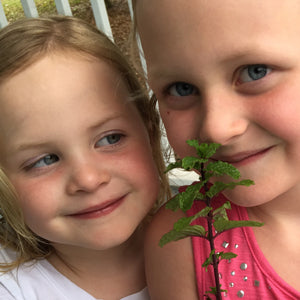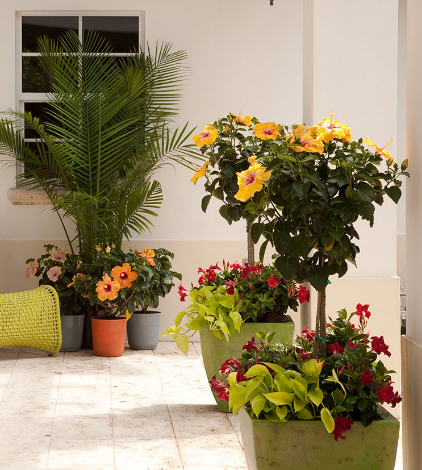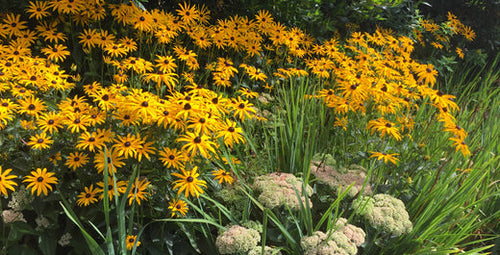
Kids Love Plants
Kids love plants. They come in a wide array of sizes, colors, textures, and scents. But there are other reasons to pair up kids with plants -- to teach them about the wonders of the natural world. There are more than 300,000 species of plants on earth. From the grass in the park to the lettuce on their plates, kids rub elbows with plants every day. Here’s a list of 10 plants that will enchant your child.

1. Lamb's Ears: Furry and Fun
Why Kids Like It
Soft, thick, white, and wooly, the leaves of lamb’s ear look like actual lambs ears. And they feel like actual lambs ears. That’s why you’ll find Stachys (aka lamb’s ears) in most children’s gardens. This sun-loving perennial draws kids in with its petable presence.
Did You Know?
Can protective armor be soft? It seems counterintuitive, but the felty exterior of lamb’s ears actually help protect the plants. The furry leaves are unappealing to munching predators such as deer and rabbits, so this plant is a favorite in areas where herbivores make a lunch of the garden. Learn how to grow lamb’s ears.

2. Butterfly Weed: Monarch Food
Why Kids Like It
What kid doesn’t love butterflies? These graceful winged wonders add more than beauty to a garden, deck, or window box -- they also help move pollen from plant to plant which helps produce our food supply. One of the most attractive plants to butterflies -- and monarchs -- in particular, is the orange-flowered butterfly weed.
Did You Know?
Monarchs use the plant species Ascelpias as a host plant for their young. What this means is that there is no other plant species that monarchs can or will lay their eggs on. By planting butterfly weed in your yard, you are really planting a nursery where monarch larvae can hatch, feed, and grow into graceful butterflies. Learn how to grow butterfly weed.

3. Snapdragons: Open Sesame
Why Kids Like
It Just their name sounds wildly magical: A dragon flower than snaps open and shut. In fact, snapdragons get their name exactly for that reason. The blooms seem to have little hinges that, when squeezed in the middle, allow the top part of the flower to open from the bottom part, looking like an opening mouth.
Did You Know?
Bumblebees and snapdragon have a special relationship. Snapdragon flowers are specifically designed just for hungry bumblebees, which are just the right weight to trip the opening mechanism of the lower lip of the flower. Lighter or heavier insects can’t gain access to nectar feast inside the flower. Learn how to grow snapdragons.

4. ‘Angelina’ Sedum: A Heady Grower
Why Kids Like It
The thick, succulent stems of ‘Angelina’ sedum make flowing tresses of “hair” for head-shape containers. This hardy groundcover turns a dour Tiki head into a party guy with a mop of Rastalike leafy locks. Plant trailing ‘Angelina’ in any heady pot and you’ll have a planter with instant personality.
Did You Know?
Some plants stand up straight and others like to sprawl. This sedum has a trailing growth habit, which makes it ideal of hanging planters or as a ground cover. Learn how to grow sedums.

5. Airplants: Plants That Love to Hang Around
Why Kids Like It
Here’s a plant that can survive the rough-and-tumble life of being owned by a kid. Airplants (aka Tillandsia) don’t need soil to grow in, which means they can sit inside any kid-built structure, such as a Lego greenhouse. Or they can be popped into an open terrarium, hung on a wall like living art, or placed in a hanging glass orb and hung in a window with clear fishing line.
Did You Know?
Airplants can have babies, which even have cute names: pups! Baby tillandsias grow around the base of the mother plant. Once they are about the same size as the mother, you can pluck them off and place them in other containers.

6. Hollyhocks: Tall, Stylish, With Hidden Talents
Why Kids Like It
Old-fashioned, hollyhocks are one of the tallest plants in the garden, and for that reason alone, kids are fascinated with them (think Jack in the Beanstock). These country charmers are biennials (they bloom every other year) and grow up to 9 feet tall. The single or double blooms come a variety of flower colors -- from pastels to bright red, and even black.
Did You Know?
Making hollyhock dolls is a whimsical activity that enchants kids (and adults). The flowers of hollyhocks look like a twirling-skirt (and a showy hat). The flower buds can be fashioned into heads and arms. Put them together with toothpicks. Learn how to grow hollyhocks.

8. Hens and Chicks: A Close Knit Family
Why Kids Like It
This plant is a like whole family in a pot: a hen and chicks, a mom and kids, a dog and puppies. The chummy nature of this low-growing plant allows kids to experience how plants multiply. The “hens” produce little offshoots (the “chicks”) that can be plucked off and planted in their own pot. The leaves are thick, fleshy, and tactile (but not prickly) and form a beautiful rose shape. Hens and chicks are a great first plant for a kid because it needs little care.
Did You Know?
In Europe this plant is called houseleek and was grown on the shingles of roofs for protection and good luck. The botanical name for this plant is Semperviven. “Semper” means “always” and “vivo” means “I live”: The very name of the plant tells you that it is long-lived. Learn how to grow hens and chicks.

10. Pansy: The Flower with the Face
Why Kids Like It
These petite flowers come in an Easter basket of colors: yellow, pink, blue, white, purple, and even a velvety black. The flat petals and interior markings make the flowers look like little friendly faces. Pansies have earned a number of personality-packed common names, such Johnny Jump-ups, Peeping Toms, and Monkey Face. If you watch the Disney film ‘Alice in Wonderland’ you’ll see a background of singing pansies that serenade Alice. Plant pansies in your garden and you’ll enjoy them for months: A pansy is one of the first flowers in the spring and the last flowers in the fall because it loves cool weather.
Did You Know?
The word pansy is derived from the French word “pensee” which means “thought”. A bouquet of pansies, in the language of flowers, means “I’m thinking about you.”

















